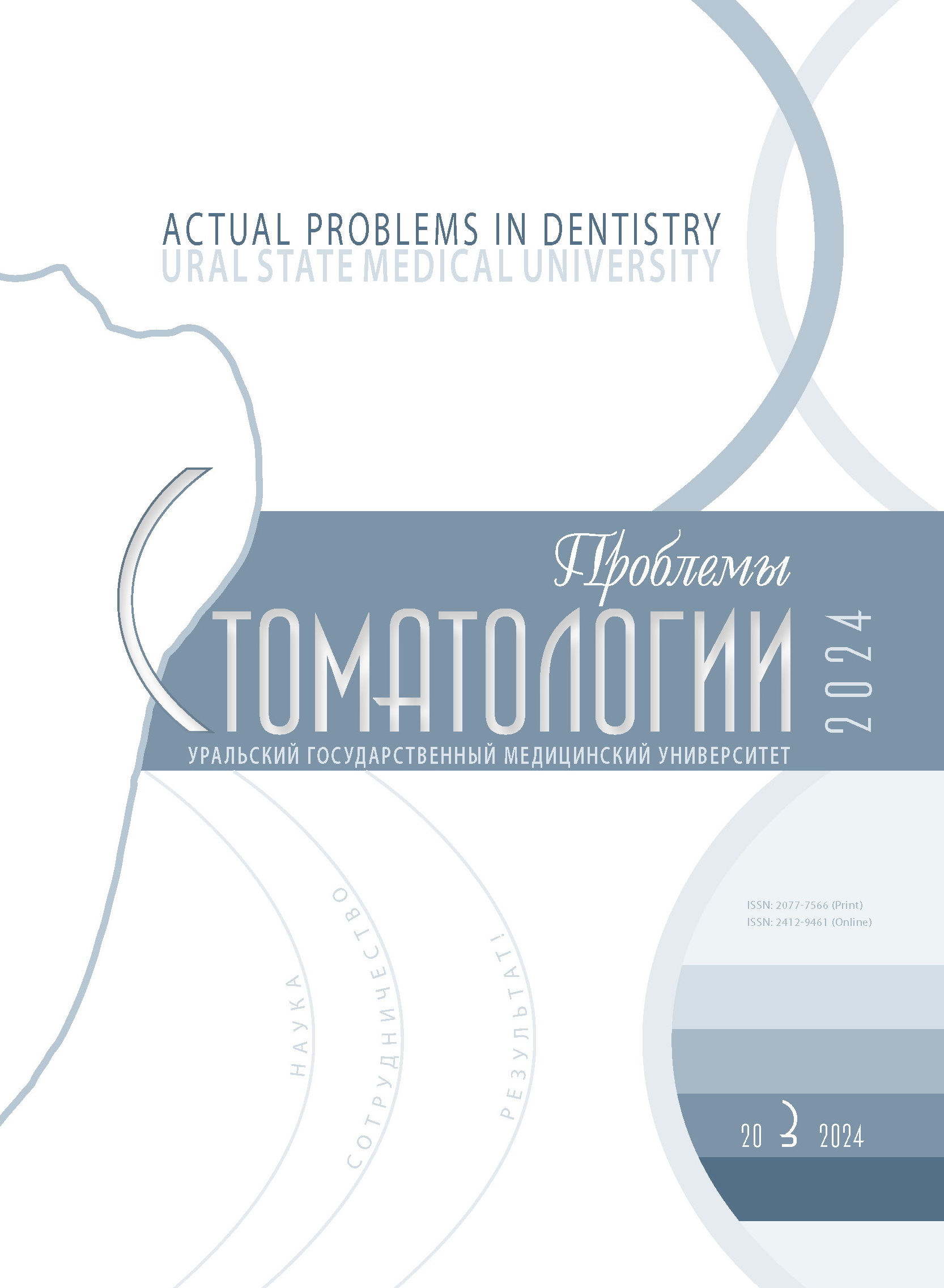Moscow, Moscow, Russian Federation
Moscow, Moscow, Russian Federation
Moscow, Moscow, Russian Federation
Russian University of Medicine (Department of Propaedeutics of Therapeutic Dentistry, Professor)
Moscow, Moscow, Russian Federation
UDC 616.31
Subject. Children's permanent teeth affected by caries at various stages of hard tissues mineralization. Objectives. To substsantiate the choice of various adhesive systems to treat dentine caries in permanent teeth with carious lesion of average intensity in incomplete and completed processes of hard dental tissues mineralization. Methodology. Clinical examination and treatment of 151 children (287 permanent teeth) for dentine caries (K02.1) aged 7 to 15 was carried out. Assessment of seals marginal integrity was carried out according to G. Ryge (1998) and using electrometric method. Results. In children's permanent teeth with incomplete processes of hard tissues mineralization, with total etching technology, unsatisfactory restorations frequency after 2 years was 21% and 57% with self-etching adhesive used. In group with total etching technology, electrical conductivity after 2 years was 42,8% lower than in that one with self- etching adhesive system. In children's permanent teeth with completed processes of hard tissues mineralization, unsatisfactory restorations frequency after 2 years was almost equal and amounted to 27% and 30%, respectively, in both groups with no significant differences in electrical conductivity rates. Conclusion. In children's permanent teeth with average carious process intensity and incomplete hard tissues mineralization processes there is a denser adhesive compound with total etching technology and in permanent children’s teeth with completed hard tissues mineralization processes there are no significant differences in marginal adhesion of fillings to dental tissues when self-etching adhesive technology of total etching is used.
dentine caries in children's permanent teeth: adhesive systems; hard dental tissues mineralization; marginal adhesion of fillings; electrical conductivity of hard dental tissues
1. Marques I.P., de Oliveira F.B.S., Souza J.G.S., Ferreira R.C., Magalhães C.S., França F.M.G., Popoff D.A.V. Influence of surface treatment on the performance of silorane-based composite resin in class I restorations: a randomized clinical trial // Clin Oral Investig. – 2018;22(9):2989-2996. doi:https://doi.org/10.1007/s00784-018-2390-5.
2. Sundfeld R.H., Scatolin R.S., Oliveira F.G., Machado L.S., Alexandre R.S., Sundefeld M.L. One-year clinical evaluation of composite restorations in posterior teeth: effect of adhesive systems // Oper Dent. – 2012;37(6):E1-8. doi:https://doi.org/10.2341/10-375-C.
3. Haralur S.B., Alqahtani M.M., Alqahtani R.A., Shabab R.M., Hummadi K.A. Effect of Dentin-Disinfection Chemicals on Shear Bond Strength and Microhardness of Resin-Infiltrated Human Dentin in Different Adhesive Protocols // Medicina (Kaunas). – 2022;58(9):1244. doi:https://doi.org/10.3390/medicina58091244.
4. Siso S.H., Dönmez N., Kahya D.S., Uslu Y.S. The effect of calcium phosphate-containing desensitizing agent on the microtensile bond strength of multimode adhesive agent // Niger J Clin Pract. – 2017;20(8):964-970. doi:https://doi.org/10.4103/1119-3077.187322.
5. Aboushelib M.N. Clinical performance of self-etching adhesives with saliva contamination // J Adhes Dent. – 2011;13(5):489-493. doi:https://doi.org/10.3290/j.jad.a19648.
6. Pereira P.N., Nunes M.F., Miguez P.A., Swift E.J. Jr. Bond strengths of a 1-step self-etching system to caries-affected and normal dentin // Oper Dent. – 2006;31(6):677-681. doi:https://doi.org/10.2341/05-131.
7. Chuiko Z.H., Kiselnikova L.P. Adhesivesystems application substantiation for cavity treatment in teeth with differing enamel mineral content // Int J Pediatr Dent. – 2009;19(1) (Abstracts of the 22nd Congress of the International Association of Paediatric Dentistry. Poster Session):73-74. https://doi.org/10.1111/j.1365-263X.2009.00993_1.x
8. Panfilov P.E., Kabanova A.V., Ivanov Yu.P., Zang Z., Kisel'nikova L.P., Shevchenko M.A. Osobennosti mineralizacii dentina v intaktnyh postoyannyh zubah u detey. Stomatologiya detskogo vozrasta i profilaktika. 2018;18(5):6-10. [P.E. Panfilov, A.E. Kabanova, Yu.P. Ivanov, Z. Zang, L.P. Kiselnikova, M.A. Shevchenko. The peculiarities of dentin mineralization in children’s intact permanent teeth. Pediatric dentistry and dental prophylaxis. 2018;18(5):6-10. (In Russ.)]. https://doi.org/10.25636/PMP.3.2018.5.1
9. Shevchenko M.A., Kisel'nikova L.P., Petrova O.I. Primenenie metoda ozonirovaniya pri lechenii kariesa dentina v postoyannyh zubah u detey. Stomatologiya detskogo vozrasta i profilaktika. 2020;20(1):55-58. [M.A. Shevchenko, L.P. Kiselnikova, O.I. Petrova. Use of the ozonation method in treating dentin caries in children’s permanent teeth. Pediatric dentistry and dental prophylaxis. 2020;20(1):55-58. (In Russ.)]. https://doi.org/10.33925/1683-3031-2020-20-1-55-58
10. Shevchenko M.A., Kisel'nikova L.P., Zueva T.E., Zhuraeva N.I. Ocenka kachestva restavraciy v postoyannyh zubah u detey s raznoy stepen'yu kariesrezistentnosti. Stomatologiya detskogo vozrasta i profilaktika. 2023;23(1):25-34. [M.A. Shevchenko, L.P. Kiselnikova, T.E. Zueva, N.I. Juraeva. Assessment of restoration quality of permanent teeth in children with different caries resistance degree. Pediatric dentistry and dental prophylaxis. 2023;23(1):25-34. (In Russ.)]. https://doi.org/10.33925/1683-3031-2023-581
11. Petersen P.E. The World Oral Health Report 2003: continuous improvement of oral health in the 21st century – the approach of the WHO Global Oral Health Programme // Community Dent Oral Epidemiol. – 2003;31(1):3-23. doi:https://doi.org/10.1046/j..2003. com122.x




















